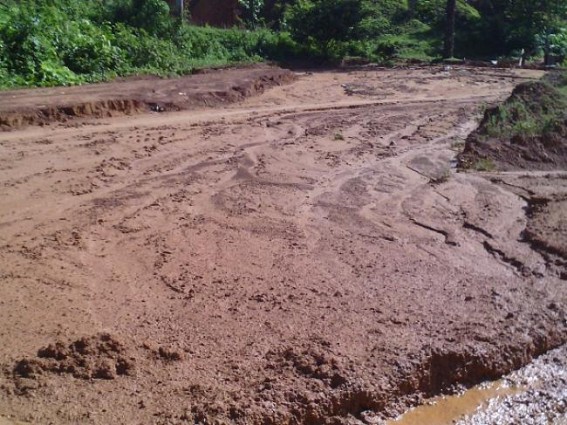TIWN Exclusive

AGARTALA, October 6 (TIWN): Tripura was part of the All India Soil Information System first in 1985 in a map form and then again in 2002. This was followed by Agro Ecological Region (AER) and agro-ecological sub region (AESR) maps, where soil and climatic information were used to delineate boundaries of regions. The state was mapped at soil family association in connection with rubber expansion project8, followed by refinement of datasets to develop soil series association map12. Later soil information was used for grid data to develop a map on soil loss in Tripura. The soils are acidic.
Due to high rainfall they are intensely leached exhibiting poor base saturation with low Cation Exchange Capacity (CEC) and therefore possessing poor nutrient holding capacity. These soils have been grouped into five classes according to their pH12,13. Nearly 46% soils are very strongly acidic (pH 4.5–5.0), followed by extremely (23.5%), strongly (12.0%), moderately (9.6%) and slightly (2.5%) acidic. On the basis of parameters of different soil series as influenced by their landscape position each soil series has been linked with a particular land use and/or crop.
In general, extremely acidic to strongly acidic soils are found in the moderate to moderately steeply sloping hills and dissected lands. These soils have loam to sandy clay loam texture. Tripura is one of the states for which relevant and pertinent data sets on natural resources are made available by the National Bureau of Soil Survey & Land Use Planning (NBSS&LUP) of Indian Council of Agricultural Research (ICAR), Nagpur, during the past decade. The Soil Information System (SIS) developed for Tripura has helped to include 15 soil series in the National Register maintained by National Bureau of Soil Survey and Land Use Planning (NBSS&LUP).
The Soil Information System (SIS) of Tripura integrates outputs from various sources across the state and may be considered useful for monitoring natural resources, modelling soil physiographic relation, finding crop suitability, land-use options, estimating soil loss and conservation of natural resources. SIS indicates that as much as 60% area of the state is under various types of degradation. If slight and moderate degrees of degradation are ignored, the extent of degradation is nearly 21% area of the state. Apart from that SIS contains datasets on soil, landscape, land use, water and climate and as such provides a spatial framework
Besides, modelling soil carbon and crop performances can also be a continuous exercise to comprehend the soil health and related changes in soils due to climate change. Two categories of soil degradation are recognized in Tripura. The first category deals with degradation by displacement of soil material, principally by water. The second one deals with the internal soil deterioration resulting from loss of nutrients (chemical deterioration) or through physical processes, including waterlogging and flooding (physical deterioration). Since soil erosion is the major reason for soil loss and consequent decline in soil productivity, it becomes imperative for the land-use managers and planners to adopt appropriate soil conservation measures. The estimates of soil erosion sometimes appear exaggerated when factual information is scarce. To make the generated output more factual, SIS developed by NBSS&LUP was utilized. The SIS can thus generate soil erosion datasets to enrich it and also make it more useful for soil conservation. Totally seven classes of soil erosion were identified. Taking the medium values of the soil erosion range, the total soil lost under different erosion
Soil conservation helps achieve three types of benefit, viz. (i) long-term reduction in checking the decline of agricultural production; (ii) gradual increase in agricultural production, and (iii) other non-agricultural benefits such as improved flow to the river during summer, reduction in periodicity and severity of flooding, reduction in siltation of reservoirs, reduction in damage of various costly infrastructure and low harmful impacts on farm lands. In Tripura many areas in the higher and middle elevations are under forest. The tilla lands and the lower foothills are used for plantation of rubber and/or for agricultural and horticultural crops. These lands are highly susceptible to soil erosion, and therefore require soil conservation measures such as bench terracing, reveal the recommendations of a NBSS&LUP related research report. Besides, Bench Terracing Tilla lands and part of the degraded lands with shrubs and bushes are now exposed to erosion due to lack of vegetation. These areas need proper afforestation programmes. Part of these areas may be recommended to be brought under rubber cultivation and other plantation and horticultural crops, suggets a study made on the issue and theme of National Agricultural Innovative Project (NAIP). Such practice will be doubly beneficial since it will save the loss of the most valuable natural resources like soil and would also generate income source among the local people.
- Two Suspected Thieves Were Arrested in Udaipur’s Kakraban
- CT Scan Machine Remains Unfunctional at GB Hospital Trauma Center
- SPO and her Husband Booked in Tripura for Job Scams
- Ranji Trophy's 2019-20 Best All-Rounder Player Manishankar Murasingh Appointed as TTAADC Brand Ambassador
- Tripura Govt ‘Discussing’ Over High Court’s Recent Verdict Against Fixed Pay System: CM cites ‘Limited Resources’



